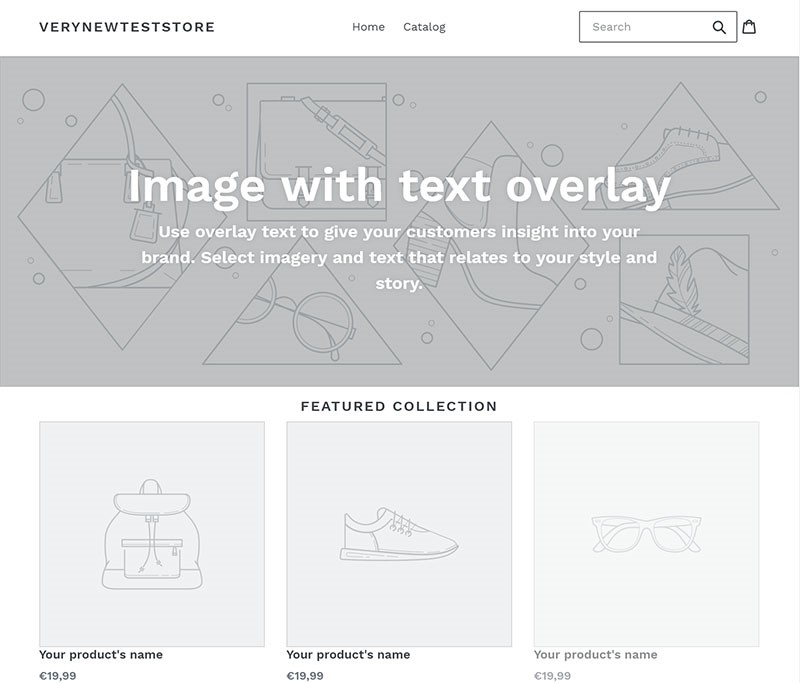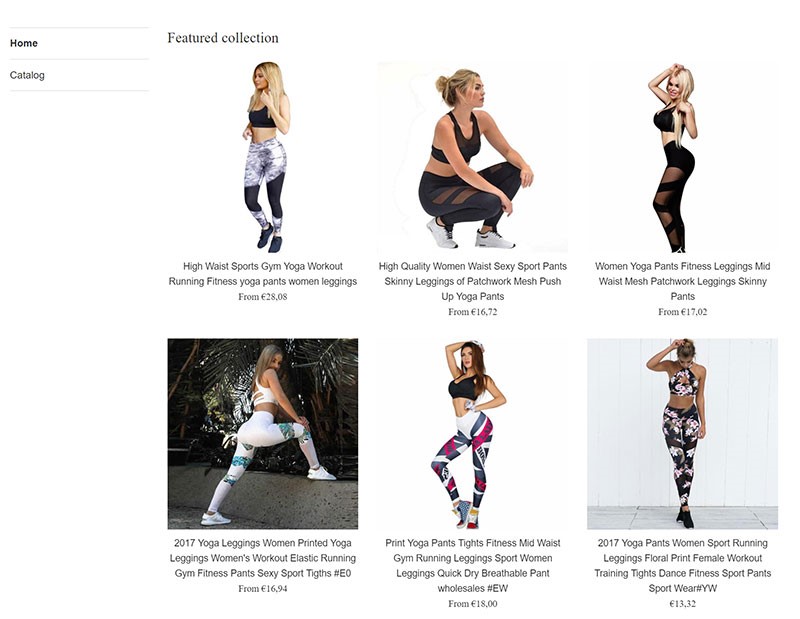

What does Shopify do and how easy it is to start with a decent-looking online store
- Oct. 21, 2020
- Rok Sprogar
Shopify is a complete ecommerce solution that has become insanely popular in an incredibly short time because it literally allows you to set up a fully functional online shop in under an hour.
And that's WITHOUT requiring of you to own a warehouse full of product, possess mad marketing skills or ANY design or technical skills.
(Of course, having either of these skills will give you an awesome head start and a significant advantage over others.)
But Shopify has actually made it possible to create a decent-looking Shopify store even if you're a total newbie to online marketing and ecommerce.
In other words, Shopify has become to ecommerce what Wordpress has become to blogging.
And the truth is (at least as far as some of the time-consuming setup tasks are concerned) Shopify has actually done an amazing job of making them even easier to set up than Wordpress.
Before we dive into the details, take a look at this brief overview of everything that I've covered in this guide:
At the highest level, Shopify will provide you with these awesome features right out of the box:
Stable, secure and reliable web hosting
It's highly likely you already know this, but:
Web hosting is a must-have online service that allows just about any kind of a website (not just Shopify stores, but also blogs, news, video, social media sites, etc.) to live, breathe, and most importantly - securely accept money from your visitors 24/7.
Unlike many other ecommerce solutions that also allow you to set up your own online store, you won't have to worry about finding a quality web hosting service if you create an online shop with Shopify.
(By quality web hosting I mean a service that actually keeps your site alive and kicking 24/7 - so without downtime, traffic interruptions and revenue fallouts - and ideally backs all of this up with a friendly, helpful and responsive customer support service.)
After years of swimming in the sea of online web hosting providers (I've personally worked with two that were so horrible I had no choice but to get a refund RIGHT AFTER setting everything up) and the flood of misinformation, fake reviews and paid-for articles, I can tell you first-hand that...
IMPORTANT TAKEAWAY: Unless you really, really know what you're doing, you should jump-start your online career with an ecommerce solution like Shopify - because it offers a reliable, constantly online, maintained and supported web hosting service out of the box.
On to another extremely important, yet potentially expensive and time-consuming thing Shopify can do for you:
The look and feel of your shop (the front end)
Most newbie online shop owners learn this the hard way:
The design of you shop's front end (the part of your online store that your visitors actually see) can easily make or break your entire business.
So if your idea is to just cram something together - like a poorly designed and slow online shop theme coupled with low quality, watermarked even copyrighted product images - then you're most probably in for a huge surprise.
But just take a look at what you'll be starting with if you open a brand new Shopify store - even if you do nothing else but sign up for a brand new Shopify account:

There's still a lot of work ahead of you, but just by signing up for a new Shopify store, you're starting off with a decent-looking and free store theme that already includes:
The layout for the "hero image", product placeholders, menu, categories, product pages, a search bar, add to cart button and last, but definitely not least, a fully functional checkout system.
And here's another amazing thing I was able to do in under 8 minutes (yes, I've timed myself) with the brand new sample store I just created:

So that's 6 live products that I've added in under 8 minutes to my new sample Shopify store - and those products are 100% ready to be browsed, bought and delivered to my visitors.
Honestly, it'd take a lot more minutes if I wanted to actually make a profit with this store, but that's beside the point here...
The point is, by the time the rest of the crowd is stuck with finding a solid web hosting service and struggling with figuring out how to get the ball rolling, you'll already have a fully functional, stable and decent-looking store foundation to kick things off with.
So on top of providing a reliable web hosting service straight out of the box, this is what Shopify can do for your store's front end:
IMPORTANT TAKEAWAY: Shopify will not only give you a fully functional and decent-looking store straight out of the box, but will also allow you to add purchasable and deliverable products to your brand new Shopify store within MINUTES of signing up.
Like I said, unless you're the luckiest person who ever started an online shop, you'll have a lot more to do before you actually make a killing online. But as far as getting things off the ground quickly goes (and doing it with as little hassle as possible), very few other ecommerce solutions even come close to Shopify.
Time to take a closer look at one more critically important thing Shopify can do for you:
Managing your store (the back end)
Most newbie Shopify store owners totally underestimate the money earning potential of the invisible part of their Shopify store - the part that's also known as the back end.
They "only" use the Shopify dashboard to edit the layout of their shop, add new products to it, change the product's prices, photos and descriptions, set up payments, manage orders, shipping and invoicing, generate discount codes, etc.
And it's true. As far as these "basic" administrative tasks are concerned, Shopify provides an awesome dashboard you can use to manage and monitor everything about your store easily and conveniently.
But to take advantage of the full money earning potential of the part of your store that remains invisible to your customers, you'll still have to step beyond what Shopify can offer from the get-go.
I'll get to that part in a bit, but here's what you should remember at this point...
IMPORTANT TAKEAWAY: Shopify will provide you with an easily understandable dashboard that allows you to manage everything from the layout of your store, menus, categories, products, accepting payments to managing orders and shipping - all of these fetures are readily available within Shopify and mostly take just a couple of clicks to set up.
But just like any other ecommerce solution, Shopify can't do EVERYTHING for you:
Bring in lots of traffic
If you ever want to run out a profitable online business, you'll have to figure out how to bring lots and lots of ready-to-buy visitors to your Shopify store.
(With me in your corner, this will be a lot easier - but still not exactly a walk in the park.)
When it comes to bringing highly-interested visitors to your Shopify store, there are basically two main roads you can take:
- The slow and steady approach to generating FREE traffic to your Shopify store.
- The fast and scalable approach to generating PAID traffic to your Shopify store.
- If you're a newbie to selling stuff online (and this is especially true if phrases like "DNS records" or "SSL certificates" sound totally foreign to you - do yourself a huge favor and forget about using your own web hosting service. Register your (first) online shop with a complete ecommerce provider like Shopify and you'll have a fast, stable and secure online shop from day one.
- If you're not a web designer yourself (or can't afford to hire one right now), Shopify will allow you to create a decent-looking store out of the box. While you'll still want to make some profitable changes to the front end of your store, you'll start with a very solid foundation.
- Shopify offers a very clean and intuitive dashboard where you can easily take care of how your store looks to your visitors (the layout, menus, products, categories, checkout pages, etc.) After that, it only takes a few clicks before your Shopify store can start accepting payments (from many built-in payment providers) - and before you set up all your shipping, billing and discount options.
- While Shopify truly does offer a very easy path to setting up a fully functional online shop, you can't expect the money to start rolling in on its own. You'll still have to do proper niche and product research and learn how to set up some high-end, profit boosting store optimizations (like email marketing and retargeting) AND learn how to bring highly-targeted traffic to your store.
Again, the details on both of these strategies aren't the focus of this guide, so at this point you should remember this...
IMPORTANT TAKEAWAY: While Shopify offers a "one click" solution to most of your online shop problems, you can't expect to simply publish your store and start making money with it. It will be up to you to attract the RIGHT kind of visitors - ones that are actually prepared to open their wallets to you.
On to the very last thing that Shopify won't be able to take care of for you:
The invisible part of your store
As you know, everything that Shopify has to offer out of the box - as awesome and complete as all those features may be - Shopify can't take care of EVERYTHING you need for a highly profitable online store.
It all starts way before your store's back end ever comes into play - with proper product and niche research. Ignoring this critically important step can easily break your business, no matter how well everything else is taken care of.
But after you learn how to NAIL product and niche selection AND create an awesome front end for your store, setting up the invisible part of your store (the back end) correctly can literally double or triple your profits from that point on.
We're talking mostly advanced stuff like email marketing and remarketing, but I can't cover the details on these profitable and advanced tactics in this basic guide. To learn more about what it will actually take for you to reach profitability, you can visit my guide to building a profitable Shopify store from the ground up.
Time to wrap this guide up.
Summary (actionable takeaways)
Here's quick and actionable summary of everything you have learned in this guide on what Shopify does (and what it doesn't do):
For more information on what it actually takes to reach profitability, you can read my thorough guide to building a profitable online store next.